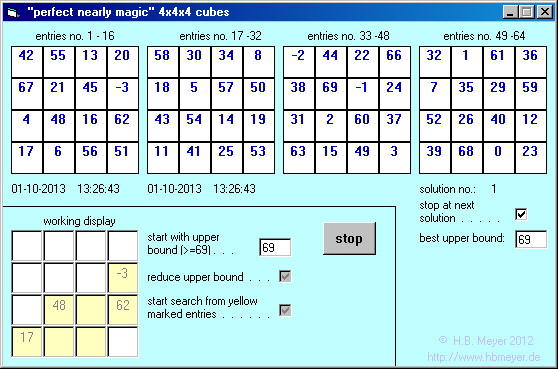| Download of a small
applet ("pernear.exe"), written in VB 5, expected to run under every | |
 |
A perfect magic 4x4x4-cube consists of 64 integers, such that any 4 entries of any straight line and of any diagonal (spatial as well as plane) have sum 130.
The 64 cube entries are called c01, c02,...,c64. Enumeration is done from front side to behind, and in every 4x4-square pane, parallel to the front pane, from top left to right below. In "s-magic cubes of order 4 are impossible" it has been shown by W.Trump, that such a cube cannot be realized with pairwise different integers, even, if only 2 of the 4 spatial diagonals have sum 130. W. Trump gives an example of a cube, using the integers 1,2,...,64, whose rows, columns, pillars and diagonals in planes parallel to a coordinate plane altogether summ up to 130, respectively, but none of the spatial diagonals does. The aim of this website is to show, that cubes with any row, column, pillar, and any "plane" diagonal summing up to 130 may have, in addition, one spatial diagonal with sum 130 and 64 different integer entries. It turns out, that these entries cannot be the integers [1,64]. The smallest interval [65-n,n] for entries is [-4,69]. entries no. 1-64: the cube entries, shown in panes parallel to the front pane, which consists of entries no. 1-16. start with upper bound: user input of an upper bound n (69≤n) for the cube entries, the search for cube entries is restricted to integers from the interval [65-n,n]. reduce upper bound: when active: after producing a solution, the program searches for a solution with a smaller upper bound. yellow marked entries: the user may prescribe start values for c08, c10, c11, c12, c13, c14, and c15 in the working display. start from yellow marked entries: when active: the search for cubes uses the yellow marked entries as start values. default values: when clicked: certain start values are written into the yellow marked fields. start: the search for "perfect nearly magic" 4x4x4 cubes begins. stop: causes a break, the user is asked whether to continue or not. date and time are displayed when the computation starts and when the computation ends. the solution number and the last found solution are displayed. stop at next solution: causes a break, when the next solution is found. smallest upper bound: the smallest found integer n, such that all cube entries are contained in the interval [65-n,n]. |
 | |
| © H.B. Meyer Magic Squares and Cubes | |